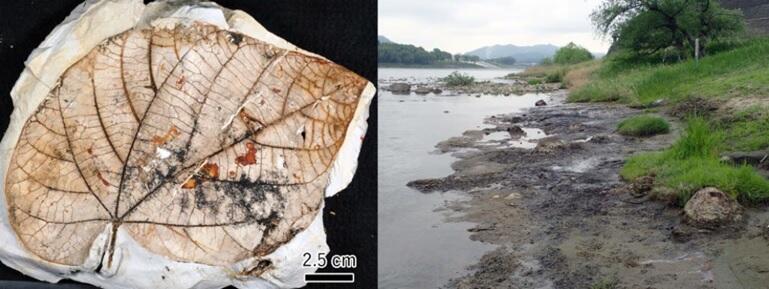The first half of the Miocene in the Cenozoic era was a warm period. The temperature on Earth approximately 16 million years ago was on average 4 ℃ higher than the current temperature. Byttneriophyllum tiliifolium, one of the representative leaf-fossil species of the warm period, has been found in a wide area of the northern hemisphere. However, only its leaves have been found.
The research group led by Professor Toshihiro Yamada of the Faculty of Science at Hokkaido University and other researchers examined approximately 130 trunks of fossil trees found in the approximately 19-million-year-old stratum that was exposed on the riverbed of the Kiso River in Minokamo City, Gifu Prefecture, and revealed that all of them were Wataria, an extinct species related to obeche (Malvaceae). The floor of this fossil forest was covered with the leaves of Byttneriophyllum tiliifolium only. In other words, the fossil forest was a pure forest. Researchers are certain that the fossil trunks and leaf fossils were from the same tree species. The results were published in Scientific Reports.

(left) Byttneriophyllum leaf covering floor of the fossil forest.
Provided by Hokkaido University
In the same way that present-day plants shed their leaves, the organs of a plant separate before undergoing fossilization. Therefore, it is very rare that a whole plant is preserved in fossil form. Large trees in particular are seldom found as complete fossils. Therefore, as a general practice, an individual scientific name is given separately to the leaves and trunks. However, to deduce the relatedness of plants, including fossils, researchers need to observe the characteristics of the various plant organs in a comprehensive manner. Byttneriophyllum tiliifolium is one of the species that were seen generally in the northern hemisphere approximately 19 to 10 million years ago. However, its relatives have not been found.
In this research study, the relatedness of the trunks to the leaves has been confirmed. It is the first time that Byttneriophyllum tiliifolium has been revealed to be in the same group as obeche.
The present-day obeche is a tall tropical tree that grows only in the central part of Africa. Byttneriophyllum tiliifolium flourished in a warm period, during which the average maximum temperature on Earth was 4 ℃ higher than the current temperature. This discovery showed that trees preferring a higher temperature spread around the world during this warm period. However, after this warm period, cooling progressed quickly. Although Byttneriophyllum tiliifolium was still growing after the start of the cooling period, it failed to resist the cold climate and became extinct approximately 6.5 million years ago. This vegetation history shows that the plants change their habitation depending on the changes in temperature. Moreover, it suggests that plants have the ability to withstand environmental changes to some extent.
Journal Information
Publication: Scientific Reports
Title: An exceptionally well-preserved monodominant fossil forest of Wataria from the lower Miocene of Japan
DOI: 10.1038/s41598-023-37211-z
This article has been translated by JST with permission from The Science News Ltd. (https://sci-news.co.jp/). Unauthorized reproduction of the article and photographs is prohibited.




